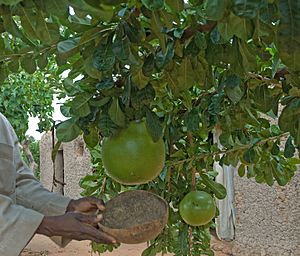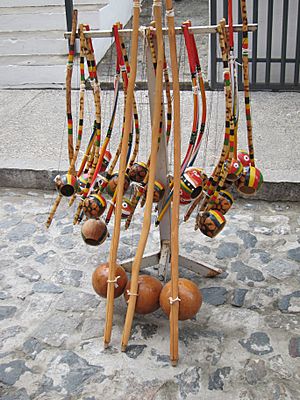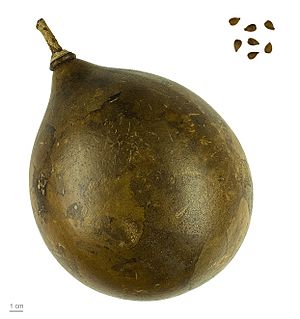Common calabash tree facts for kids
Quick facts for kids Common calabash tree |
|
|---|---|
 |
|
| Fruiting branches, and showing bowl made of the hard rind of a fruit of that tree (Koutiala District, Mali, September 2014) | |
| Scientific classification | |
| Genus: |
Crescentia
|
| Species: |
cujete
|
The calabash tree (scientific name: Crescentia cujete) is a special flowering plant. It grows naturally in the Americas. You can also find it in Africa, Central America, South America, the West Indies, and even in southern Florida. This tree is very important. It is the national tree of St. Lucia.
The calabash tree can grow up to 10 meters (about 33 feet) tall. It has simple leaves. These leaves grow either one by one or in small groups on short branches. The tree is also found in India. It shares its common name, "calabash," with another plant. That plant is a vine called the bottle gourd.
Contents
How People Use the Calabash Tree
People around the world use the calabash tree in many creative ways. Its hard fruit is especially useful.
In the Caribbean
In the Caribbean, people often use the calabash fruit to make everyday items. They turn the dried fruit into cups, bowls, and basins. These are great for carrying water or fish.
Artists in some Caribbean countries decorate and paint calabash fruits. They sell these beautiful items to tourists. In Haiti, the plant is called kalbas kouran. This means "running calabash." It is used to make a special rattle for religious ceremonies. This shows how much people respect the plant.
In Cuba, farmers often use the dried fruit as a coffee cup. In the Dominican Republic, the tree is called the higüero tree. People use it to make decorations. In the past, it had many other uses too.
In Costa Rica
The town of Santa Bárbara de Santa Cruz in Costa Rica has a special yearly dance. It is called the "dance of the calabashes" (baile de los guacales). This event is very important to the community's culture. Everyone who joins gets a hand-painted calabash. This is a thank you for their support.
Native Americans in Costa Rica also use calabash bowls. They serve a drink called chicha in them. This happens at special events like the "dance of the little devils" (baile de los diablitos).
In Mexico
In many parts of rural Mexico, people dry and hollow out the calabash fruit. They call it a bule or a guaje. It works like a canteen to carry water. The fruit can also be cut in half. These halves are called jícara. They are used for serving food or drinks. Clay cups are also called jícara because they look similar.
In Brazil
In Brazil, people once used calabash bowls for serving food. Some remote areas still do this, especially Native American groups. The fruit is also a key part of a musical instrument. It is used as the sound box for the berimbau. The berimbau is the main instrument for capoeira. Capoeira is a mix of martial arts and dance.

In Colombia
In Colombia, people cut the dried fruit in half. They fill it with small items like stones, beads, or seeds. Then, they use it to keep the rhythm in bullerengue music. In many Latin American countries, including Colombia and Cuba, people make maracas. They fill the dried fruit with seeds and add a handle.
In Africa
In Western and Southern Africa, the calabash is used for decorations. It is also made into musical instruments. Women who dig for gold by hand use calabash bowls. They use them to 'pan' for and find small pieces of gold.
See also
 In Spanish: Crescentia cujete para niños
In Spanish: Crescentia cujete para niños


